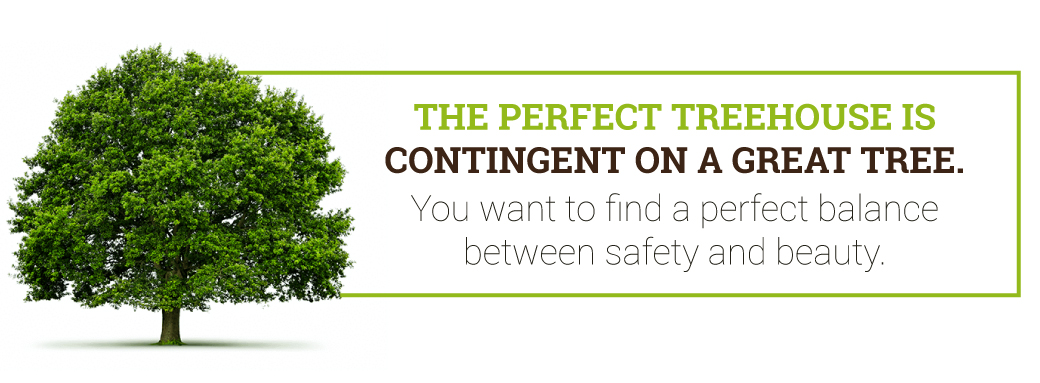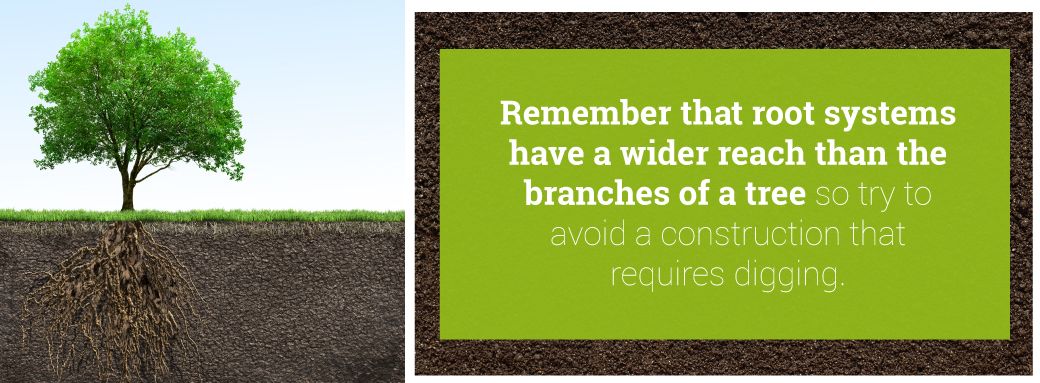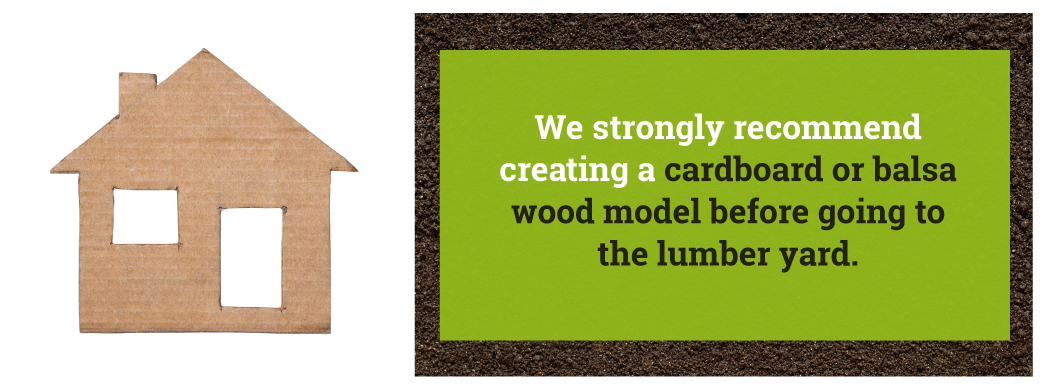
The Ultimate Guide: How to Build a Treehouse
Jump to:
- Start With a Great Tree
- Make Sure Your Treehouse Is Up to Code
- Make Sure Your Neighbors Are On Board
- Start Work On Your Design
It is the ultimate vision of a young kid: getting off the bus from school, throwing their backpack down in the doorway and then climbing into their treehouse.
For kids (and kids-at-heart) there is nothing quite as adventurous as the perfect treehouse.
So if you are looking to provide your family with the ultimate treetop hangout, look no further than this — our ultimate guide to building a treehouse. As the leading tree experts in Virginia, we have the experience to help you with the entire project from start to finish. We’ll help you pick the best trees for a treehouse and then give you sound advice on making sure your tree house is safe and secure. We’ll even give you a few design ideas along the way.
Don’t delay. Get started choosing a tree for a treehouse and designing right away!
Start With a Great Tree
Of course, the perfect treehouse is contingent on a great tree. You want to find a perfect balance between safety and beauty.
With that in mind, here are some of our pro-tips for choosing the best tree for your treehouse:

1. Make sure the tree is healthy.
To start, you want your tree to be healthy enough to support the weight of both your treehouse and its occupants.
Keep in mind, no matter how gentle you are, when you build a treehouse you are adding stress to that tree. If a tree is already fighting against some sort of disease or is, due to its location, struggling to get the light and water it needs, the added stress of a treehouse will likely be too much for it.
If you are really committed to a particular tree but you know it has some health issues, you can turn to a professional tree service or arborist to help you nurse the tree back to full strength before building your house. But that being said, the easiest and safest route is to avoid diseased trees all together.
2. Hardwood is better.
When you attach your treehouse, there are some factors to consider. First, you need to make sure your materials are strong enough to support the structure. But your tree also needs to be strong enough to support the fasteners. That’s why hardwood works so well.
When a fastener is attached to a tree, if it is rated for the weight of your structure, it will not bend or break. However, the wood in which it is fastened can start to compress. That compression can be worrisome for a number of reasons. To begin with, it can be hard to notice, meaning your treehouse may not be as structurally sound as it appears. Second, you never want your fasteners to loosen. Compressed wood can allow your fasteners to loosen, which can lead to sudden and potentially dangerous shifts in your treehouse. So when choosing a type of tree for your treehouse, stick to oak, walnut, cherry or hickory if you can.
There are fasteners and designs that are meant for softer woods like pine, poplar and redwood. So just because your best treehouse tree is a softer wood doesn’t mean it’s disqualified. However, if that is the case, you want to make sure you do your homework and design a treehouse that is appropriate for softer woods.
3. Your favorite tree might not be the best tree.
If you have a lot of land and there is one tree in particular you love, it can be tempting to place your treehouse there. However, keep in mind, a treehouse can be hard on a tree, and when you are in your treehouse, you will be spending most of your time looking around at other trees.
That’s why we recommend choosing the tree next to your favorite tree for your treehouse. This will give you the perfect vantage point while also ensuring your favorite tree isn’t put under the stress of treehouse construction.
This is especially true if you know a thing or two about tree species, and your favorite tree is rare in your area. You don’t want to put a rare specimen at risk.
4. Consider environmental impact.
Treehouses are a wonderful way to observe and enjoy your environment, but treehouses are not natural. They add stress to the environment and can, if done improperly, have a significant negative impact on the area. So make sure you are doing all you can to build your treehouse with as little of an impact on the environment as possible.
For example, if you expect a good deal of traffic to and from your treehouse, consider placing it in a location where a footpath is already established. Foot traffic compacts soil, so you don’t want to drastically change the ground in an area unnecessarily.
You also want to make sure your family is familiar with tree care. While children have long been carving their initials into trunks, this is actually really hard on the tree. So too is peeling bark or pounding on trees with branches or other objects without reason. Use your treehouse as a tool for teaching your family about respecting trees.

Finally, remember that tree root systems have a wider reach than the branches of a tree. So if you can, avoid a construction that requires digging, as you may inadvertently damage a surrounding tree.
5. Seek a professional opinion.
Even if you are confident in your building skills, it’s still wise to get a tree expert to come out and confirm a tree is suitable for a treehouse. This will likely be a quick trip, but failing to have your tree inspected can have long-term consequences.
Make Sure Your Treehouse Is Up to Code

Now that you have your tree chosen, it’s important to make sure you aren’t violating any local building codes.
Every area has its own building codes, and sometimes figuring them out requires a little research. The specifics of the codes can range from how close you can build a treehouse to other structures to the height of your treehouse. Unfortunately, there are some areas where the codes are strict enough that you may not even be able to build your treehouse as planned.
However, the cost of violating building codes can follow you for a long time. Keep in mind that if you ever do violate a building code, it may go unnoticed for a while. But if you go to sell your home, you may find yourself in hot water. Just because no one says anything right now doesn’t mean you’ve gotten away with a code violation.
Make Sure Your Neighbors Are on Board
It is true that as long as your treehouse is up to code, you have the right to build it on your property. However, just because you can doesn’t always mean you should.
Keep in mind, if you live in a community, neighbors can take action against you and your home/landscape if they are disgruntled. By having a conversation with them first, you will help avoid potential future legal and neighborly issues.
Besides, being a good neighbor is a best practice anyway! You are building your treehouse to better enjoy your surroundings. You don’t want to damage a portion of those surroundings by filling them with angry neighbors!
Also Check With Your Insurance Agent
The truth is, while there is plenty you can do to ensure you and your family is safe while enjoying your treehouse, there will always be risks and safety concerns.
Consider these statistics collected by the College of Medicine at the Ohio State University. From 1990 to 2006, there were around 47,000 emergency room visits among those under 19 years old caused directly by treehouses — and 78.6% of those injuries were caused by falls.

Statistics like these have drawn the attention of homeowners’ insurance companies that will potentially be on the hook for any treehouse-related injuries, so make sure you check in with your insurance company. Treehouses and other play structures may not be covered by your homeowners’ insurance, in which case you will have to pay for injuries out of pocket. Others may cover such things as treehouses, but you may need to adjust your policy accordingly.
Either way, you want to make sure you know what is covered and what isn’t before building your treehouse.
Start Work on Your Design
Now that you have all your ducks in a row, it’s time to start thinking about your design.
There are a couple of routes you can go. If you aren’t confident in your own structural design abilities, there are plenty of designs available online. These can range from simple single-room treehouses to more intricate designs, so make sure you choose one that fits your particular skill level.
If you are opting for a template, just make sure you have accurately measured your tree. While these templates are designed with some variation in mind — since no two trees are alike — there are limitations to the types of trees they can accommodate.
If you are designing your own treehouse, instead, we strongly recommend creating a cardboard or balsa wood model before going to the lumber yard. By modeling your treehouse to scale, you can get a better sense of tricky areas or places in you design that require special attention.

Additionally, you need to make sure your design accounts for tree growth. Just because you are placing a treehouse on a tree doesn’t mean the tree will stop growing. While trees obviously grow slowly, if you don’t give your tree some room to grow, you will find that your structure will become unsound in just a few seasons.
Finally, if you are designing your own treehouse, you’ll want to use the proper materials. While earlier generations may have made treehouses with whatever materials they could find, this isn’t the safest approach. You want to make sure all of your materials are rated for supporting the weight of your structure and its maximum number of occupants. In fact, as treehouses have become more popular, specific tools and materials have been designed just for treehouses.
You also need to choose your support method. Again, this is a very important step where safety is concerned. There are three support methods to choose from.
- Post Method: This is actually the least environmentally impactful method of supporting your treehouse. Rather than strapping or bolting your treehouse to the tree, you use sunken posts to support the structure. Think of this as building a deck around a tree.
- Bolt Method: This is the traditional approach, and you literally bolt the treehouse into the tree. This impacts the tree the most, so do so with care. You also need to make sure you are using bolts that are designed for treehouses, as others may cause more damage than a tree can sustain.
- Suspension Method: This is another minimally invasive approach. Instead of bolting the house to the tree, the whole structure is suspended from strong limbs. However, this method also limits the amount of weight that the structure can withstand, so be mindful of how large your treehouse will be and how many people you plan on having in it.
You will next need to figure out how people are going to get into your treehouse. You can purchase a standard ladder from a hardware store, or you can instead opt for a rope ladder. Just remember that rope ladders can be challenging for certain climbers. Or, if you are an accomplished carpenter, you can build a traditional staircase.
You also need to incorporate the non-supporting branches into your design. Part of the charm of a treehouse is adapting the structure to the tree rather than the other way around. That means making sure you have holes cut into your structure that will leave space for smaller branches to continue to grow.
Finally, you want to make sure your treehouse is as safe as possible. That means making sure there are sufficient railings and that you have made the ground beneath the treehouse as soft as possible in the event someone does fall. Wood mulch is a great material to use as it will also keep the ground beneath your tree more attractive.
Also, make sure your treehouse isn’t too high. We recommend not making the platform for your treehouse any higher than six to eight feet.
Who to Turn to for Tree Services in Virginia
If you are building a treehouse in Virginia, then you are going to want to make sure you have tree professionals available to support you. Even if you plan on completing the entire project yourself, you always want to have someone you can turn to in case you get stuck or something in your design goes wrong.
Luckily, here at Richard’s Tree Service, we have been providing tree services in Northern Virginia for over 20 years. We serve much of the D.C. metropolitan area, and we have made community connections throughout Northern Virginia and Maryland.
We are family owned and operated, meaning we have made an investment in this community that we call home. And we think that’s fitting for a treehouse partner, since isn’t that what you’ll be doing when you tackle your building project? You will be investing in your family and in your home. So turn to a partner who gets the value of that!
If you are looking to have a tree evaluated or simply want to meet with a professional tree specialist as you plan your treehouse project, contact us today. We look forward to partnering with you as you build your palace in the trees.
If it is an emergency please call us immediately at 703-354-3667.
Use this form to schedule a FREE estimate. After submitting your form, our team will contact you to set up this appointment.
